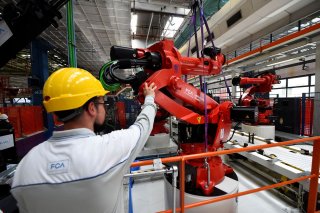These Cool Sci-FI Stories Show What the Future of Jobs and Automation May Look Like
Robots everywhere?
Before the coronavirus pandemic, some polls suggested Americans worried a lot about robots taking their jobs. And if they were worried before, those fears seem likely to escalate thanks to COVID-19 and a possible long-term focus on more social distancing and less human contact in the workplace. Already, according to the recent New York Times piece “Robots Welcome to Take Over, as Pandemic Accelerates Automation,” recycling services have increased their orders for robots to sift through the material. And it’s hardly a stretch to think that social distancing needs will make robots a more attractive option at fulfillment warehouses. Then again, some store cashiers might be happy to have their jobs automated away if it means a different retail job with less customer interaction.
Indeed, one reason people have always been uncomfortable with automation is that it’s easier to imagine losing a current job than gaining a new one that might not currently exist. What will the jobs of the future look like? It’s a frequent question for labor economists and technologists.
Some possible answers — or at least new ways of thinking about that question — might be found in “Working Futures” from late 2019. It’s an intriguing anthology of 14 speculative stories about the intersection of jobs and advancing automation. The pieces emerged from a 2018 scenario-planning exercise in San Francisco involving some 50 techies, entrepreneurs, investors, lawyers, and others. The resulting 10 “future worlds” were then sent to science fiction writers to be used as launching pads for their imaginations. In the book’s introduction, editor Michael Masnick writes that each story “contributes something to our thinking on the future of innovation and work, and what the world might soon look like—in both good and bad ways.”
In “The Chaperone” by Andrew Dana Hudson, Jan is a customer service rep for a company that sells personalized AI assistants. It’s her job to make sure the owners, usually men, don’t get too emotionally attached to their cyberservants. When Jan isn’t “breaking hearts for the richest company in the world” — one under constant threat of nationalization by the new socialist federal government — she lives in a FEMA camp outside Atlanta for climate change refugees.
Another favorite of mine is “Joan Henry vs. The Algorithm” by Randy Lubin, an updating of the American folk tale about John Henry, the “steel-driving man” who dies after racing and defeating a steam-powered, rock-drilling machine. The specific contest this time around is between the title character and an AI competitor over who’s the better virtual reality gamemaster. But actually Joan’s entire working life has been a race against one machine or another. From that piece:
Joan had been outrunning the algorithm her entire adult life, re-skilling and transitioning across myriad roles ahead of their automation. She’d seen countless friends and colleagues succumb, unable or unwilling to adapt to the shrinking labor pool. Not Joan—she’d survived thanks to marathon study sessions, endless networking, and a knack for knowing the right time to switch to the next hot micro-profession. She cherished her identity as a professional—hard working, creative, empathetic, and flexible. Living off basic income was not an option; she would not become another economic dropout. When Joan started as a Maestro, she thought she’d be safe for at least a few years. The synthesis of real time storytelling, worldbuilding, and acting for a live audience seemed far too complex for any algorithm to master. Just eight months later and her job was already on the line.
Among the other future jobs explored: a third-party human resources officers for AI workers getting hired, fired, or transferred; preschool teachers for genetically modified kiddies; a “life services broker” to help consumers navigate among the megacompanies supplying all their subscription-based services, from housing to healthcare to education; and a virtual reality therapist who lets CGI “prints” handle the easier stuff, although the patient may not know it.
These aren’t really dystopian stories, although some depict worlds with big problems. Technology might help create a better society in some ways, but not a perfect one. And while technology might totally automate some jobs, in others it allows humans to do more. In a “A Quiet Lie” by Ross Pruden, here’s how VR shrink Phyllis manages patients:
Her huge monitor currently held live sessions of 20 other patients, scattered throughout the world. One patient was in Sri Lanka, another in Idaho. Four of them were active military and six were vets. The rest were civilians of varying ages. Just like her patients, Phyllis interacted with [AI helpers] David and Clancy as facilitators. Leveraging human mimicry at this level of competency helped Phyllis see a much larger caseload than she could have done only five years ago. With large-scale tragedies like that awful cruise ship collision last year, she could see as many as 50 clients at once, if needed. That meant more patients, less overhead, and more time… which meant more pro bono work. At rough count, she had saved at least three lives in the last year from those pro bono sessions, all because she could afford to spare time for it.
We need more speculative efforts like these, especially post-pandemic when there are sure to be some significant labor market and workplace changes in addition to the ones generated by new tech. We need stories about how things might work out, even if they’re not all positive.
This article by James Pethokoukis first appeared in 2020 on the AEI Ideas blog.
Image: Reuters.

